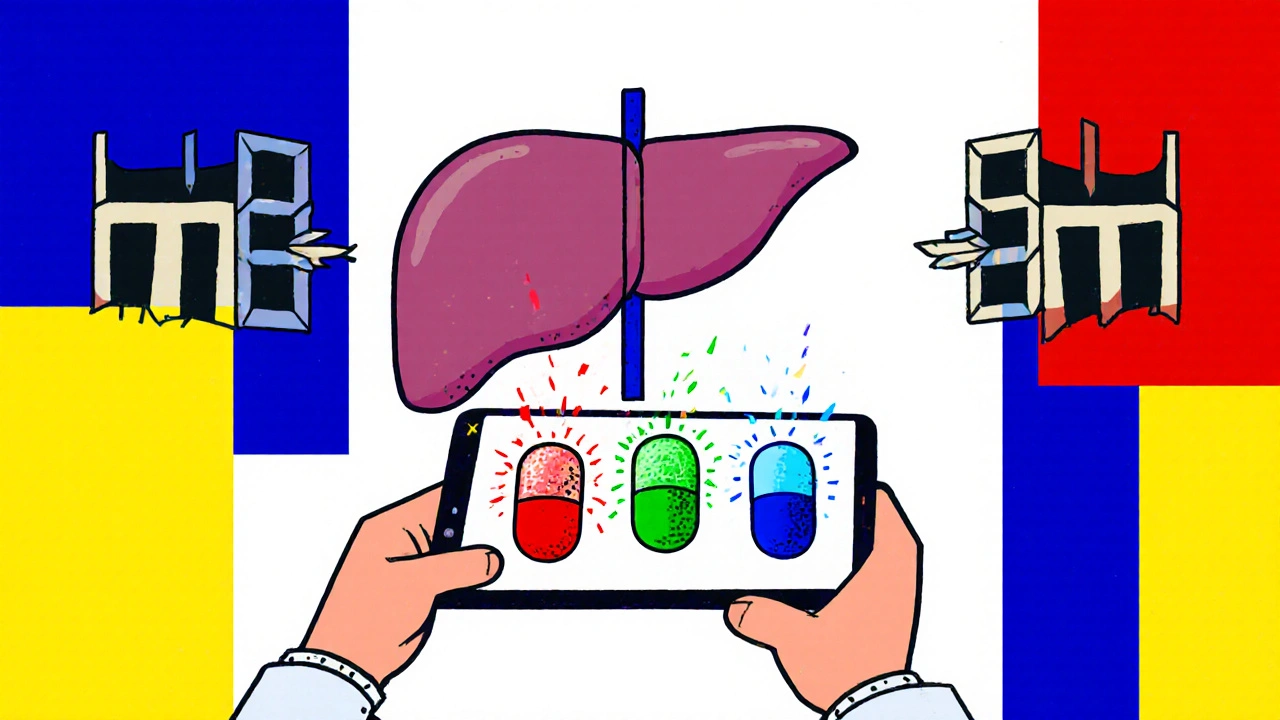Statin-Antifungal Interaction Checker
Check Your Medication Safety
This tool checks dangerous interactions between statins and antifungal medications. Some combinations can increase drug levels by 10-20 times, risking muscle damage, kidney failure, or death.
Why Your Antifungal Could Be Dangerous with Your Cholesterol or Transplant Meds
If you're taking a statin for high cholesterol or an immunosuppressant after a transplant, and your doctor prescribes an oral antifungal for a stubborn yeast or fungal infection, stop and think. This isn't just a routine prescription combo-it’s a potential medical emergency waiting to happen.
Systemic antifungals, especially the azole class like fluconazole, itraconazole, and posaconazole, don’t just kill fungi. They also slam the brakes on your body’s natural drug-cleaning system. This system, built around enzymes like CYP3A4, is what breaks down your statins and immunosuppressants. When these enzymes get blocked, drug levels in your blood can spike-sometimes by 10 to 20 times. That’s not a typo. That’s enough to trigger muscle breakdown, kidney failure, or even death.
How Azole Antifungals Hijack Your Metabolism
Azoles work by blocking a fungal enzyme called lanosterol 14-alpha-demethylase. But here’s the catch: that same enzyme family exists in your liver. The human version, CYP3A4, is responsible for metabolizing about 30% of all prescription drugs-including most statins and all major immunosuppressants.
When you take an azole antifungal, it doesn’t just target the fungus. It latches onto CYP3A4 like a lock jammer, stopping your body from clearing out statins like simvastatin, atorvastatin, and lovastatin. The result? These drugs pile up in your bloodstream. One study showed that ketoconazole and posaconazole can raise simvastatin levels by up to 20 times. That’s not just elevated-it’s toxic.
Even worse, azoles also block transporter proteins like OATP1B1, which normally help move statins out of the liver. So even statins you think are “safe,” like pravastatin or rosuvastatin, can become dangerous under the influence of ketoconazole. This isn’t theoretical. Real patients have ended up in the hospital with creatine kinase levels over 10,000 U/L-signs of rhabdomyolysis, where muscle tissue literally melts and clogs your kidneys.
Which Statins Are Most at Risk?
Not all statins are created equal when it comes to drug interactions. Here’s what you need to know:
- High risk (CYP3A4-dependent): Simvastatin, lovastatin, atorvastatin. These are the most dangerous when paired with azoles. Simvastatin is especially vulnerable-even a low dose can become lethal.
- Moderate risk: Fluvastatin and pitavastatin. These use other metabolic pathways but can still be affected by strong inhibitors.
- Lower risk (but not safe): Pravastatin and rosuvastatin. These rely less on CYP3A4, so they’re often the go-to alternatives. But here’s the catch: ketoconazole still blocks OATP1B1, which can push pravastatin and rosuvastatin levels up too. Don’t assume they’re risk-free.
The FDA and American College of Cardiology both warn: never combine simvastatin or lovastatin with strong CYP3A4 inhibitors like ketoconazole or posaconazole. Period. Even atorvastatin requires caution. If you’re on one of these statins and need an antifungal, your doctor should switch you to pravastatin or rosuvastatin-or pause the statin entirely.

Immunosuppressants Are Just as Dangerous
If you’ve had a kidney, liver, or heart transplant, you’re likely on cyclosporine, tacrolimus, sirolimus, or everolimus. These drugs keep your immune system from attacking your new organ-but they also inhibit CYP3A4 and P-glycoprotein. That means they do the same thing as azole antifungals: they make your statins stick around longer than they should.
In transplant patients, studies show that combining statins with cyclosporine can increase statin levels by 3 to 20 times. One patient on simvastatin and cyclosporine developed rhabdomyolysis with CK levels above 20,000 U/L. Another needed dialysis. These aren’t rare cases. They’re textbook outcomes of ignoring interaction warnings.
And here’s the kicker: many transplant patients also have high cholesterol. So they need statins. But they’re also at higher risk for fungal infections because of their suppressed immune systems. This creates a perfect storm. The very drugs that save their lives can, if paired wrong, destroy their muscles and kidneys.
What to Do If You Need an Antifungal
You can’t just quit your meds cold turkey. But you also can’t ignore the risk. Here’s how to handle it safely:
- Stop high-risk statins. If you’re on simvastatin, lovastatin, or atorvastatin, your doctor should pause them before starting an azole antifungal. Keep them off until the antifungal is fully cleared from your system. Posaconazole sticks around for 24-30 hours after the last dose-so wait at least a full day after finishing the course before restarting.
- Switch to a safer statin. If you still need cholesterol control, pravastatin (10-40 mg daily) or rosuvastatin (5-20 mg daily) are the best choices. But even these should be started at the lowest dose and monitored closely.
- Check your immunosuppressant levels. If you’re on cyclosporine or tacrolimus, your blood levels should be checked before and after starting an azole. These drugs often need their doses cut by 30-50% when paired with strong CYP3A4 inhibitors.
- Watch for muscle symptoms. Unexplained muscle pain, weakness, or dark urine? Call your doctor immediately. These are early signs of rhabdomyolysis. Don’t wait.
- Ask about alternatives. Isavuconazole is a newer azole with weaker CYP3A4 inhibition. For some patients, it’s a safer option. And research is underway on drugs like olorofim, which doesn’t interact with CYP enzymes at all. Ask if these are options for you.

Why This Keeps Happening
Despite clear guidelines from the American Heart Association, Infectious Diseases Society of America, and the FDA, these dangerous combinations are still prescribed far too often.
Why? Because statins are everywhere. About 39 million Americans take them. Fluconazole alone is prescribed over 5 million times a year in the U.S. Doctors are busy. Prescribing systems don’t always flag the risk. A 2012 study found that even with clear label warnings, CYP3A4 inhibitors and statins are co-prescribed in nearly 1 in 5 cases.
But it’s getting better. Hospitals with electronic health systems that auto-flag drug interactions have cut these dangerous combos by 47%. Pharmacist-led verification programs-now used in 87% of academic medical centers-have reduced high-risk prescriptions by 63%. These aren’t just policies. They’re lifesavers.
What’s Next? Personalized Medicine and Safer Drugs
Some people have a genetic variation in the SLCO1B1 gene. About 12% of the population carries it. That gene controls how your body takes up statins into the liver. If you have this variant and take a statin with a CYP3A4 inhibitor, your risk of muscle damage is much higher.
Genetic testing isn’t routine yet-but it should be, especially for transplant patients or those with a history of muscle pain on statins. In the future, your doctor might check your genes before prescribing any statin.
And the drug pipeline is improving. New antifungals like olorofim, which works by a completely different mechanism, show almost no CYP450 interaction in early trials. That means patients on statins or immunosuppressants might soon have a safe option for fungal infections without having to stop their life-saving meds.
Bottom Line: Don’t Guess. Ask.
If you’re on a statin or immunosuppressant and your doctor says, “Take this antifungal,” say: “Is this safe with my other meds?” Don’t assume it’s okay. Don’t rely on the pharmacy to catch it. Bring a list of every pill you take-including vitamins and OTC drugs. Ask if your statin needs to be switched or paused. Ask if your immunosuppressant dose needs checking.
This isn’t about being difficult. It’s about survival. One wrong combo can end in the ICU. But with the right questions and the right choices, you can treat the fungus without risking your muscles, your kidneys, or your life.
Can I take fluconazole with my statin?
Fluconazole is a moderate CYP3A4 inhibitor and a strong CYP2C19 inhibitor. It’s safer than ketoconazole or posaconazole, but still risky with simvastatin, lovastatin, or atorvastatin. If you need a statin while on fluconazole, switch to pravastatin or rosuvastatin at a reduced dose. Avoid high doses of fluconazole (over 200 mg/day) if you’re on any statin.
What if I accidentally took simvastatin with itraconazole?
Stop the simvastatin immediately. Call your doctor or go to urgent care. Symptoms like unexplained muscle pain, weakness, or dark urine could mean rhabdomyolysis. Your doctor will check your creatine kinase (CK) levels and kidney function. Even if you feel fine, this combination can cause delayed damage-so don’t wait for symptoms.
Are there any antifungals that don’t interact with statins?
Yes. Terbinafine (Lamisil) is an allylamine antifungal that doesn’t inhibit CYP enzymes. It’s often used for nail fungus and is a safe alternative for patients on statins or immunosuppressants. For systemic infections, isavuconazole (Cresemba) is a newer option with weaker CYP3A4 inhibition. Always confirm with your pharmacist or doctor before switching.
Can I take a lower dose of simvastatin to make it safer?
No. Even the lowest dose of simvastatin (5 mg) can become toxic when combined with strong CYP3A4 inhibitors like itraconazole or posaconazole. The interaction isn’t dose-linear-it’s exponential. The FDA and ACC both state: avoid simvastatin entirely with these antifungals. No safe dose exists.
Why do some doctors still prescribe these combos?
Many doctors aren’t aware of the full risk, especially in community settings. Electronic alerts help, but they’re not perfect. Some assume the patient’s statin is “low risk,” or they’re focused on treating the infection and miss the interaction. A 2012 study found that over 20% of statin-azole combinations were still prescribed despite clear warnings. Always double-check your own meds.
Should I get genetic testing for SLCO1B1 before taking statins?
It’s not standard yet, but if you’ve had muscle pain on statins before, or you’re on immunosuppressants, it’s worth asking. About 12% of people have a genetic variant that makes them more sensitive to statin toxicity. If you have it and need an antifungal, your doctor may choose a non-CYP3A4 statin or avoid statins altogether during treatment.

Comments (9)
joe balak
November 2, 2025 AT 11:20
This is wild. I had fluconazole last year and didn't even think to ask about my statin. Guess I got lucky.
Vrinda Bali
November 4, 2025 AT 03:59
The pharmaceutical industry knows this. They don't care. They profit from your organ failure. You think they want you to live? They want you on more drugs. Always.
Amina Kmiha
November 4, 2025 AT 23:35
I knew it. 😵💫 Every time I see a doctor, they hand me a new pill like it's candy. Then I end up in the ER with muscle pain. Now I bring a printout of every interaction to every appointment. They hate it. Good.
John Rendek
November 6, 2025 AT 08:37
Good post. Really important info. If you're on immunosuppressants, talk to your pharmacist before filling any new script. They're trained to catch this stuff. Don't wait for the doctor to remember.
Sonia Festa
November 8, 2025 AT 04:22
So basically if you're not rich enough to afford a 3000$ genetic test, you're just gonna roll the dice with your muscles? 😅 Classic US healthcare. My cousin took fluconazole with simva and ended up in ICU. Took 6 months to walk again. No one warned her. Not even the pharmacy.
Ryan Tanner
November 9, 2025 AT 04:44
Big shoutout to pharmacists who actually call you when they see this combo. 🙌 I had one do that last year. Saved my life. Don't underestimate the guy behind the counter.
Cornelle Camberos
November 9, 2025 AT 05:14
The CYP3A4 enzyme system is not merely a metabolic pathway-it is a biochemical fortress that, when compromised by azole antifungals, precipitates a cascade of iatrogenic catastrophe. The regulatory frameworks governing drug interactions remain woefully inadequate, and the failure to mandate preemptive genotyping for SLCO1B1 variants constitutes a systemic dereliction of duty by the medical establishment. The prevalence of this lethal confluence is not an accident-it is the inevitable outcome of profit-driven pharmacological neglect.
Iván Maceda
November 10, 2025 AT 10:55
I'm not saying the gov't is behind this... but why do all the safe antifungals cost 10x more? 🤔
Sara Allen
November 10, 2025 AT 16:29
i just read this and now i think my doctor is trying to kill me. i take cyclosporine and simva and fluconazole and i dont even know if i should be alive. i think i need to move to canada. or maybe just stop taking all my meds. what do you think? 😭